No 1: Derge Parkhang/ Derge Printing House
Derge Parkhang is founded in 1729, and the construction completed in 1750 during the reigns of his successors. The famous Sakya Pa scholar Zhuchen Tsultrim Rinchen edited Gargyur and Tangyur. The Tibetan book of Gargyur and Tangyur are knowns as the most accurate and completed Tibetan Buddhism scripture. There are total of 217000 wooden printing blocks housed in the this printing house and the works of this print house has been used all cross Tibet Plateau. Today, Dege Parkhang printing house is still functioning as it was a century years ago, all the works are done by manual. It became the biggest printing house in Tibet. The printing house produces traditional mathematic, science, Tibetan medicine books and scriptures and books from Nyingmapa, Gelukpa, Kagyupa and Sakyapa as well as Bon religion.
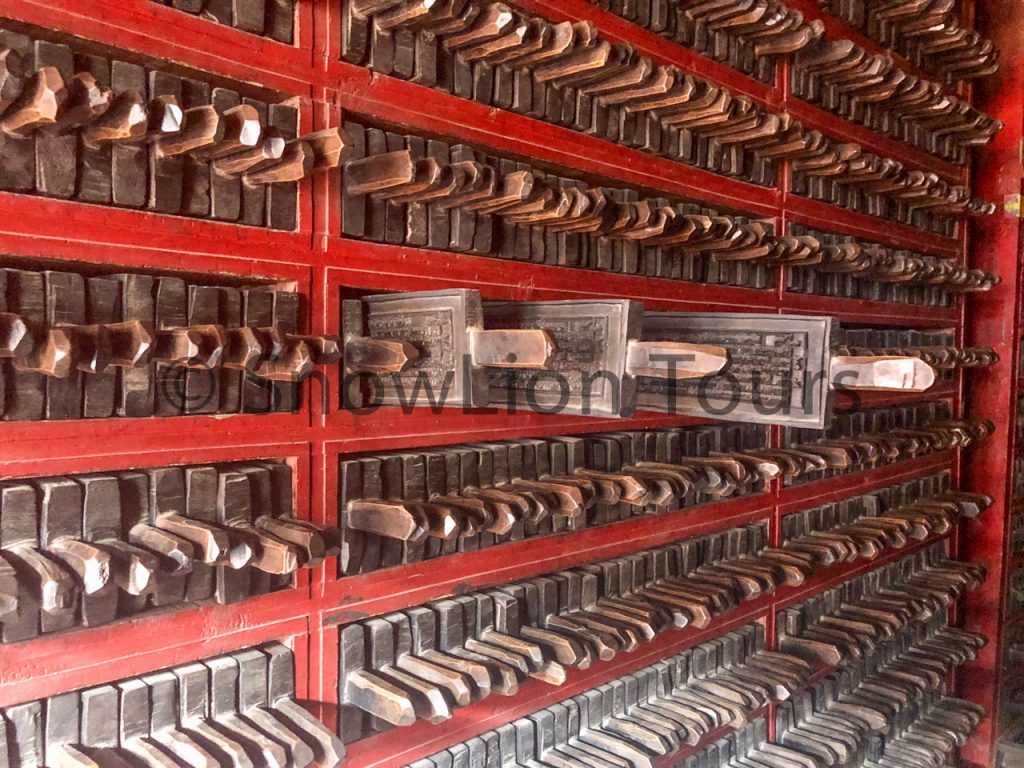
One of largest traditional Style of printing house in Tibet. Many Tibetan books printed from this Printing House.
No 2: Dzongsar Monastery
Dzongsar monastery is a Sakya monastery which is located in Derge. It was a Bonpo monastery founded by a Bonpo Lama originally. And temples which were built by the Bonpo Lama remained until 1958. The original Bonpo monastery was converted into a Nyingma and a Kadampa temple at some stage. In 1275 it was founded as a Sakya monastery by Drogon Chogyal Phagpa on his return from China. Dzongsar used to between 300 and 500 permanent resident monks, But all the temples were destroyed in 1958, but rebuilding began in 1983 under the guidance of Dr. Lodro Phuntsok. The monastery had twenty three temples, large and small, and many important sacred rooms. It contained hermitages such as Khamshe Shekdra, Karmo Taktsang retreat centre, Gargu Shangchub Rihtrek retreat centre, Zamnang Pema Shelpuk, Zingkhok Trawo retreat centre, Tsedrak Drulphuk, Gyalgen Chungtak, Munong Dorjee Drakal, Tsa-chu-juk Chenresig Lhakang, Honda Thongthong Gyalpo, and others. Dzongsar had a unique collection of Rimé scriptures and teachings, gathered by the proponents of the Rime movement, Jamgon Kongtrul, Chokyi Lingpa and Khyentse Wangpo. Although Dzongsar was a Sakya monastery by principle it was known to be flexible in its teachings and made it possible to study eight sects of Buddhism. Dzongsar also has a Shedra. Which is also consider to be built since 1918. But also destroyed 1958 with the main monastery.
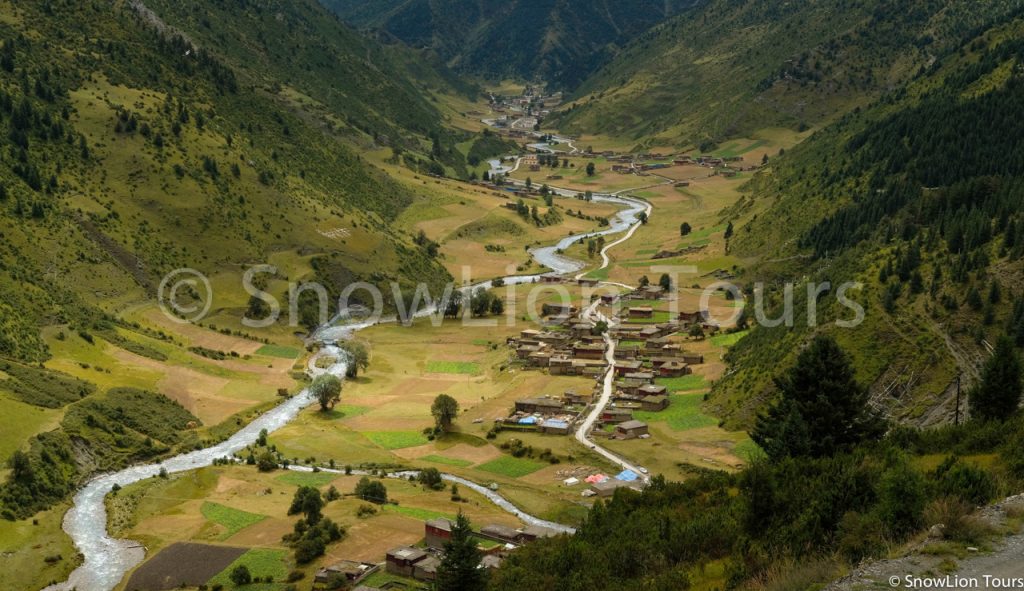
Beautiful villages nearby Dzongsar Monastery
No 3: Palyul monastery
Palyul Monastery was built by Lhachen Jampa Phuntsog, the first Dharma King of Dege. It was constructed on a site which possesses all the essential auspicious signs and had been blessed by the presence of many great mahasiddhas. In a prophecy from the treasure revealer Sang-ngag Lingpa, it is written of Palyul, “The rocks clearly display self-originating images of Vajrapani as well as blue Hum syllables with radiating flames. Both the unsurpassed practice cave of Yeshe Tsogyal and the Secret Accomplishment cave of Padmasambhava are located there…At Namtsong rock [located in front of the Palyul monastery] thirteen secret termas have been concealed.”
In 1982 Penor Rinpoche returned to Palyul for the first time after leaving Tibet. He visited the main Palyul Monastery and many of its branch monasteries. Thousands came to received the blessings, empowerments and teachings which he bestowed. He ordained over 500 monks and made generous offerings to the members of the sangha. He also gave donations to support the reconstruction of the monastery.
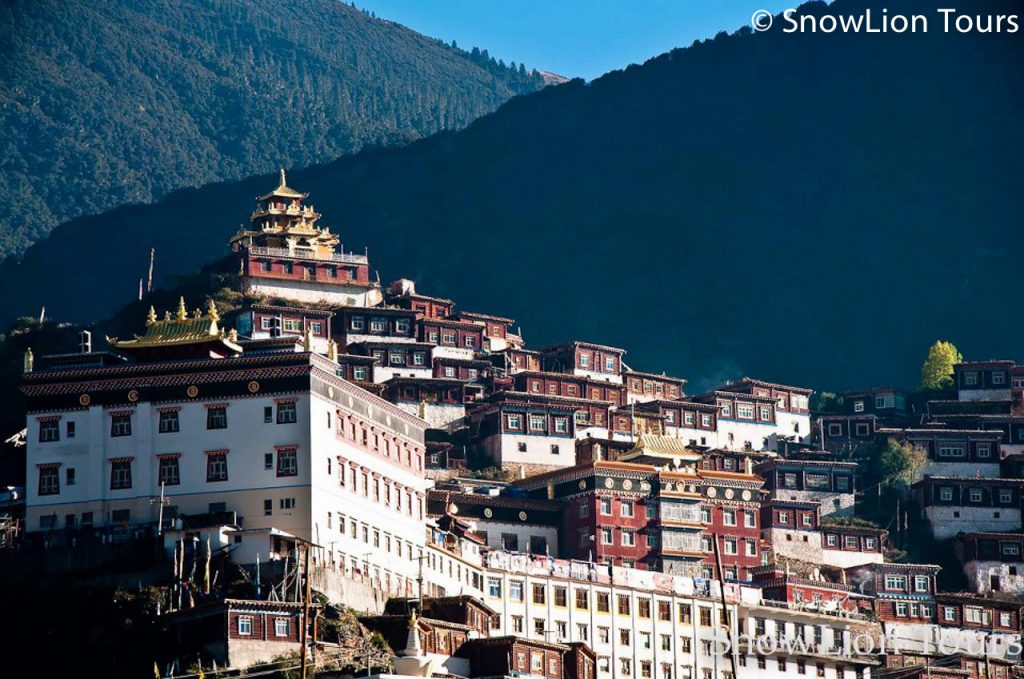
One of the magnificent Monastery in SIchuan Province
Yilhun Lhatso Lake & Trola Mountain
Yihun Lhatso or Yilung Lhatso is a glacial lake in the area between Dege and Manigango. Yihun Lhatso located in a valley on the north side of the Trola Mountains at the foot of Rongme Ngatra. It is found 10km south of the town of Manigango.. The lake occupies a u-shaped valley and is contained by the former terminal moraine of a glacier originating from Rongme Ngatra that has now receded to 4,100 m (13,500 ft) above sea level. The lake is drained by the Tro Chu, a tributary of the Yalong River which eventually joins with the Yangtze. The lake is passed by Highway 317 on its way over Trola mountain pass. As part of the historic Kham region in Tibet, Yihun Lhatso has long been known to the Tibetan people. It is considered a sacred lake in Tibetan Buddhism and a kora route circles the lake. The lake and adjacent streams are known for the hundreds of boulders that have been carved into mani stones.
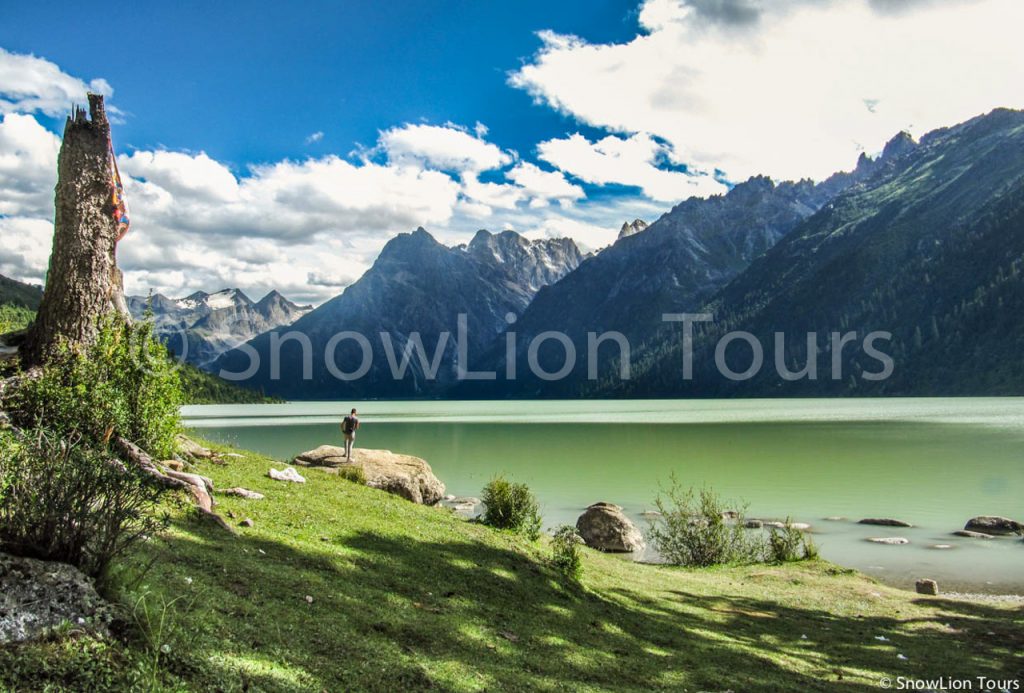
Stunning landscape view from all direction from this Lake.
Jyekundo & Mani stone culture (Rock Curving Mantras)
Jyekundo or Yushu is a mojor Tibetan town located in Qinghai Province in the northwest region of Kham. Jyekundo town is found along the tributary of the Drichu (Tongtian He), which contribute to upper reach of mighty Yangtse River(Changjiang). Mani stones are stone plates, rocks and/or pebbles, inscribed with the six syllabled mantra of Avalokiteshvara (Om mani padme hum, hence the name “Mani stone”), as a form of prayer in Tibetan Buddhism. The term Mani stone may also be used in a loose sense to refer to stones on which any mantra or devotional designs (such as ashtamangala) are inscribed. Mani stones are intentionally placed along the roadsides and rivers or placed together to form mounds or cairns or sometimes long walls, as an offering to spirits of place or genius loci. Creating and carving mani stones as devotional or intentional process art is a traditional sadhana of piety to yidam. Mani stones are a form of devotional cintamani.
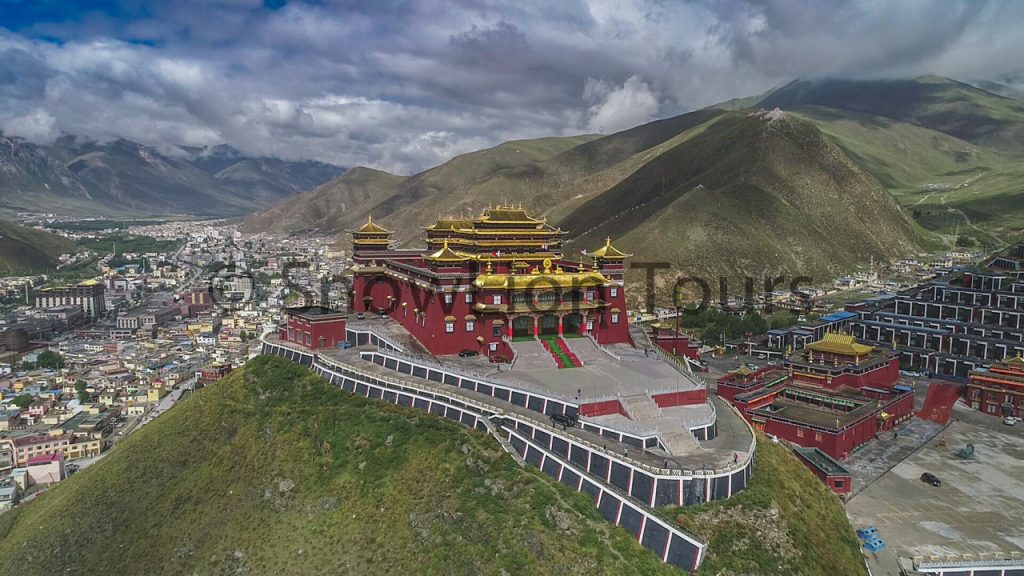
The largest monastery in Yushu
Nangchen & Gar monastery
Nangchen is a county of the Yushu Tibetan Autonomous Prefecture and is the southernmost county-level division of Qinghai province, bordering the Tibet Autonomous Region to the south. It was one of the five kingdoms of the historical region of Kham. Nangchen town located in a side valley and on the right bank of the Dza Chu, upper reaches of the Mekong river. Gar monastery is located south of Nangchen Sharda town about 60km and built in 18thcentury, it is also a Drigungpa monastery of Kagyu sect of Tibetan Buddhism. There are 50 monks, and most of them are young novices. They are studying under the guidance of Gargon Tulku and Gargon Chetsang.
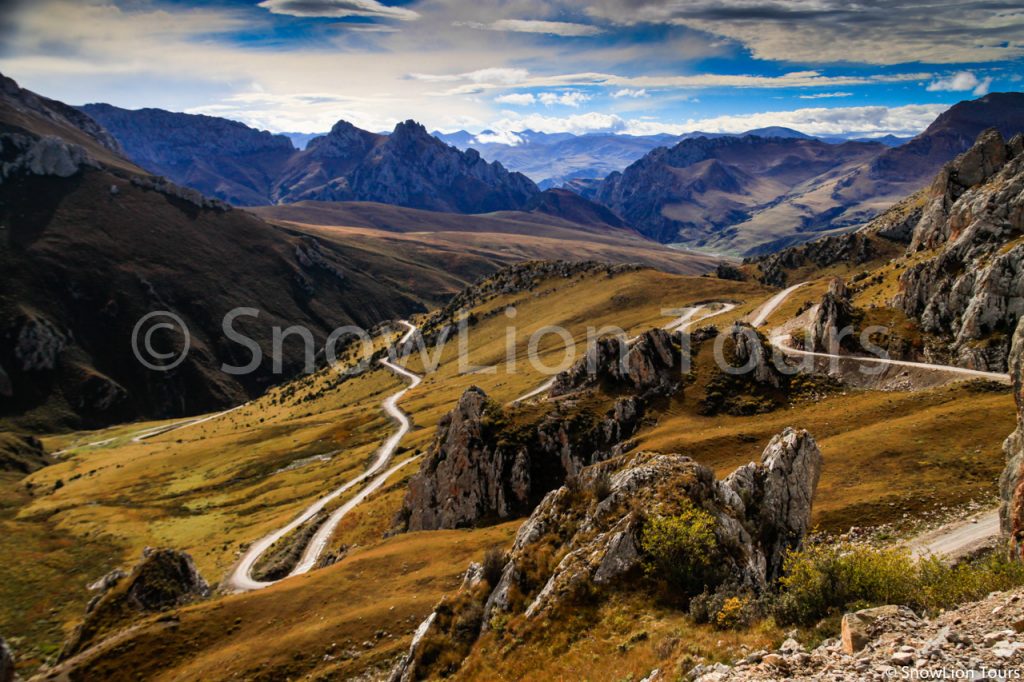
The view on the road to Nangchen from Yushu.
There are small mani stone mounds and some dedicate murals depicting the lords of three enlightened families. The older buildings at Gar monastery were restored in 1980s. The new Tsuklhakhang alongside them has excellent gilded copper images on the left wall depicting Gampopa, Milarepa, Marpa, Naropa, Tilopa, and Vajradhara. The inner sanctum contains images of Amitayus, Drigung Kyabgon and Padmasambhava.
Rebkong
Rebkong is 180km south of Xining city in Qinghai Province, located in the Golden Valley of the Rongwu Guchu River in Malho or Huangnan Prefecture. The valley is at about 2600m (8500 feet) above sea-level, extends from the north to south, and is surrounded by several mountains. Rebkong is famous for its Tibetan traditional arts and cultural preservation. There are several monasteries and villages scattering around the Rongwu town which are the home to hundreds of artists. The most well known villages and monasteries are Senggeshung Yago and Sanggeshung Mago (upper and lower Wutun), Gomar Gompa, Nyamtok village, etc.. If you are interested in learning Tibetan culture and Tibetan traditional arts, Rebkong is one of most recommended region. Almost every house is turned into an artists studio. These unofficial school of art are inherited from 18th century. Many of the Tibetan arts you have seen in Amdo are produced by the masters of Rebkong region. There are many monasteries stretches both side of the valley. There are Sanggeshung Yago (Upper Wutun), Sanggeshung Mago (Lower Wutun), Gomar Gompa, Nyantok Monastery, Yershong Gon, Tokya Tashi Chopenling, Yarma Tashikyil Gompa, Gartse Gompa. Most of them are the branch monasteries of Rongwu Gonchen. There are two famous festivals in Rebkong are the Shaman Festival in summer and Monlam Great Prayer festival in winter
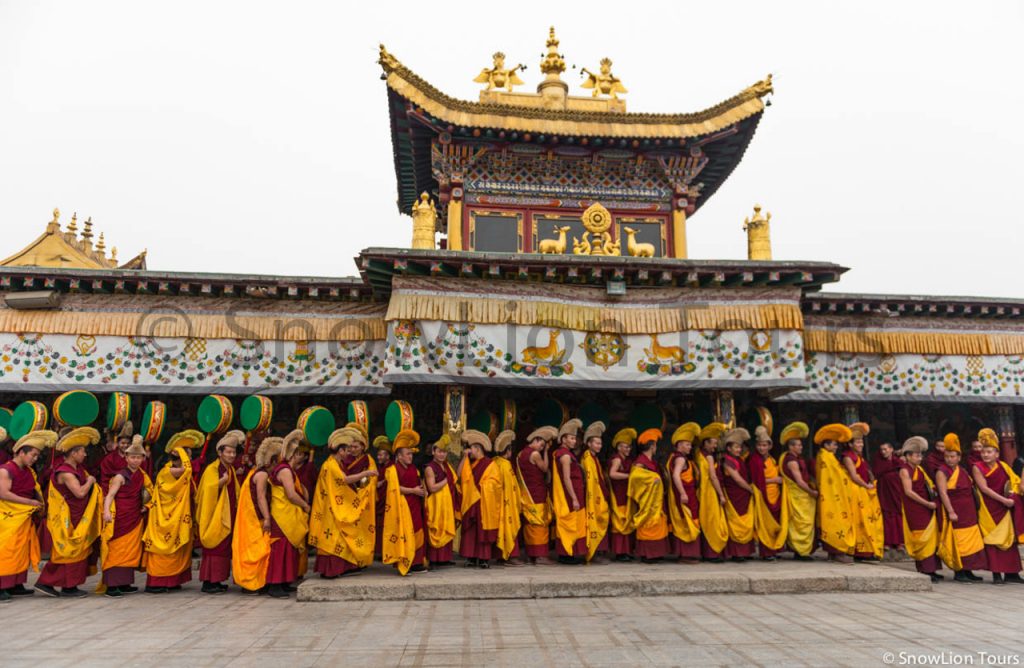
Rongwo Monastery Monks on parade.
Labrang Tashikyil Monastery
Labrang town sprawls along the banks of Shangchu River (see above picture). It’s a one street town and is predominantly Hui Muslims on the east side of the town and Tibetans at the west end. Labrang Monastery which is one of the Six great Monasteries in Tibet lays the edge of the west town at the north shore of Shangchu river. The monastery is founded in 1709 by The First Jamyang Gyapa Ngawang Tsondru (1648-1721) who studied at Drepung Monastery in Lhasa. In his age of 53 to 60, he was the abbot of Drepung Gomang monastery in Lhasa. During his study in Lhasa, he received the title “Jamyang Gyapa” (laughing Manjushri), when a statue of Manjushiri (Tib: Jamyang) laughed at his prostrations in the Manjushiri temple in Lhasa. Jamyang Gyapa’s later reincarnations become the abbot of Labrang Monastery since then. His reincarnations are superseded by H.H The Dalai Lama and Panchen Lama, the two highest ranks of Lama in Tibetan Buddhism. Once he returns to Labrang, he founded the great Monastery of Labrang.
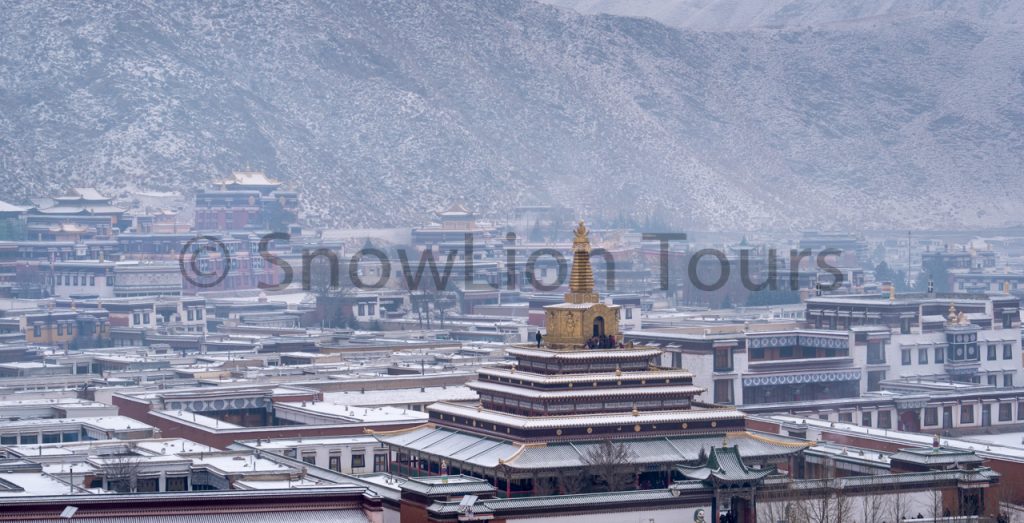
One of the Six Greatest Monasteries in Tibet.
Kumbum Monastery
Kumbum Monastery (Ch Ta’er si) is one of the six great monasteries of the Gelugpa school of Tibetan Buddhism, is famous for being the birthplace of the great religious reformer Tsongkhapa. The full name is Kumbum Jampaling Monastery. It is a wonderful place to check out Tibetan religious culture, Tibetan architecture, and Tibetan art. Highlights at the monastery include a large butter sculpture, murals, and applique embroidery. Another highlight is the daily monastic debating holds at the assembly court a front of the Assembly hall 5-6 pm. Kumbum Monastery (ch Ta’er si),was founded in 1583 by the Third Dalai Lama, Sonam-Gyatso (1543-1588). It was built at the site where Tsongkhapa (1357-1419), the founder of the Gelugpa Tradition, had been born. According to Tibetan Text books, a drop of blood fell from Tsongkhapa’s umbilical cord when it was cut after his birth. From this drop grew a wondrous white sandalwood tree. It has about 100,000 leaves, which it never sheds. In Tibetan, the number 100,000 merely signifies a very large number and is not meant literally. On each leaf is an image of the Buddha Sinhanada (Seng-ge sgra). On the bark of the branches and trunk are the designs of the seed syllables and hand implements of this Buddha. In the future, Tsongkhapa will take birth as Sinhanada, the eleventh Buddha of the 1,000 who will grace the earth during this fortunate eon.
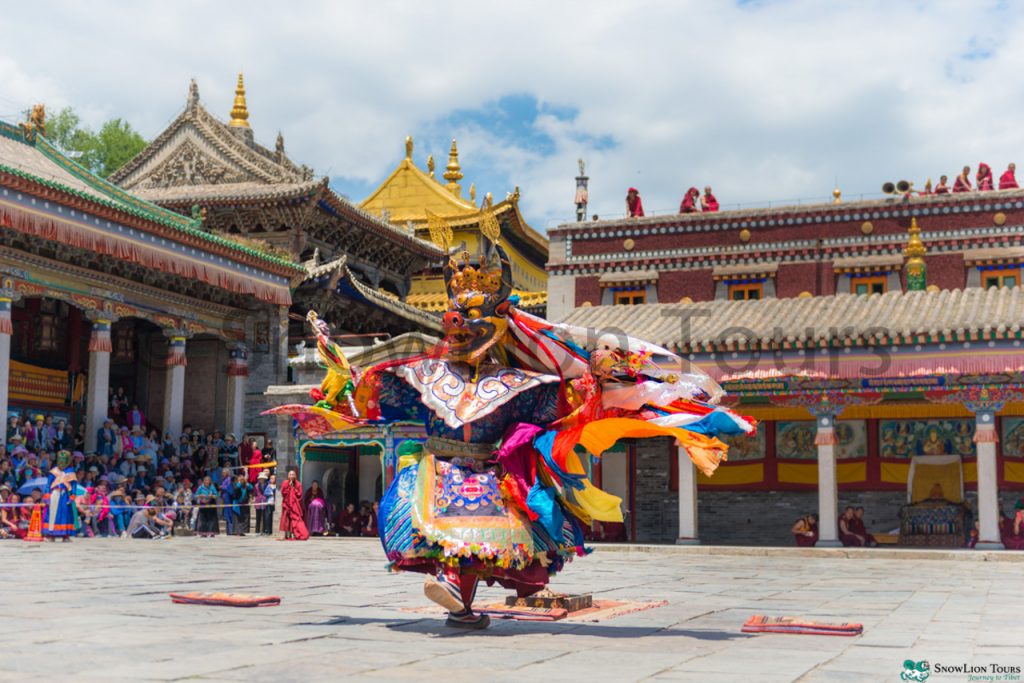
There are several festivals in the monasteries. This is one of the interesting time to visit Kumbum.
Qinghai Lake & Kokonor Lake
Qinghai Lake is on the top 5 most beautiful lakes in China. The following photo is taken in the Island of the lake which is in the center of the lake. It is a Tibetan Buddhist retreat centre as well as small monastery on the top of this about football size island. Qinghai Lake (Tib Tsongongpo, Mogol Lake Kokonor ) is at an elevation of 3200m. The Qinghai Province named after the lake. It is the largest lake in all of China and largest salt lake in Asia. Qinghai Lake is regarded as holy by Tibetans and Mongolians and this is also the sea offering site for Penchen Lama. You can see sea offering site at the south shore of the lake. At the south shore of the lake (150km from Xining), take a boat ride on the turquoise waves of the lake or go horseback riding along the shores with Tibetan nomads.
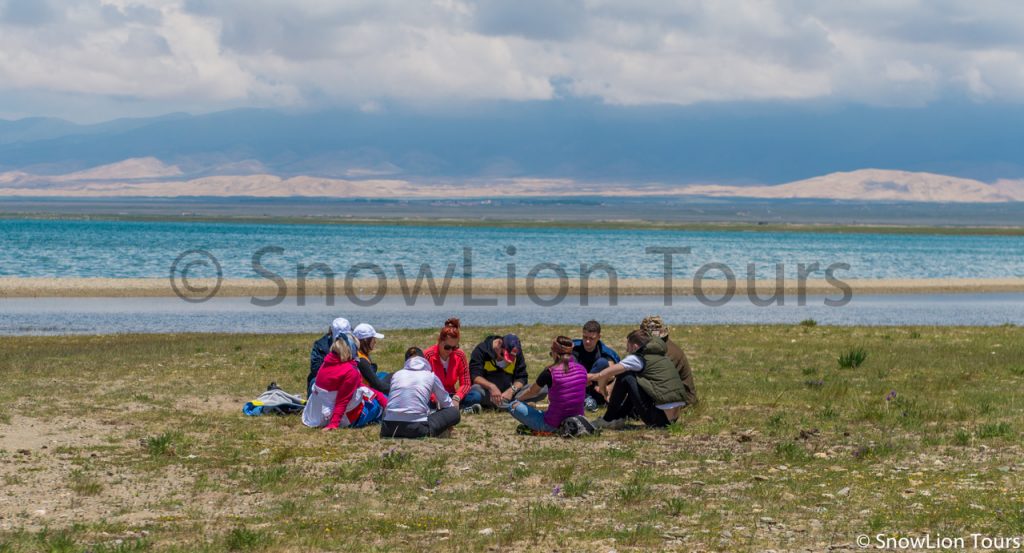
One of our group at Qinghai Lake enjoy a relaxing day.
If you have an extra day, continue on to the northwest side of the lake (220km from Xining), where you can visit Bird Island, a breeding ground for black-necked cranes, sandpipers, wild geese, and other bird species.





